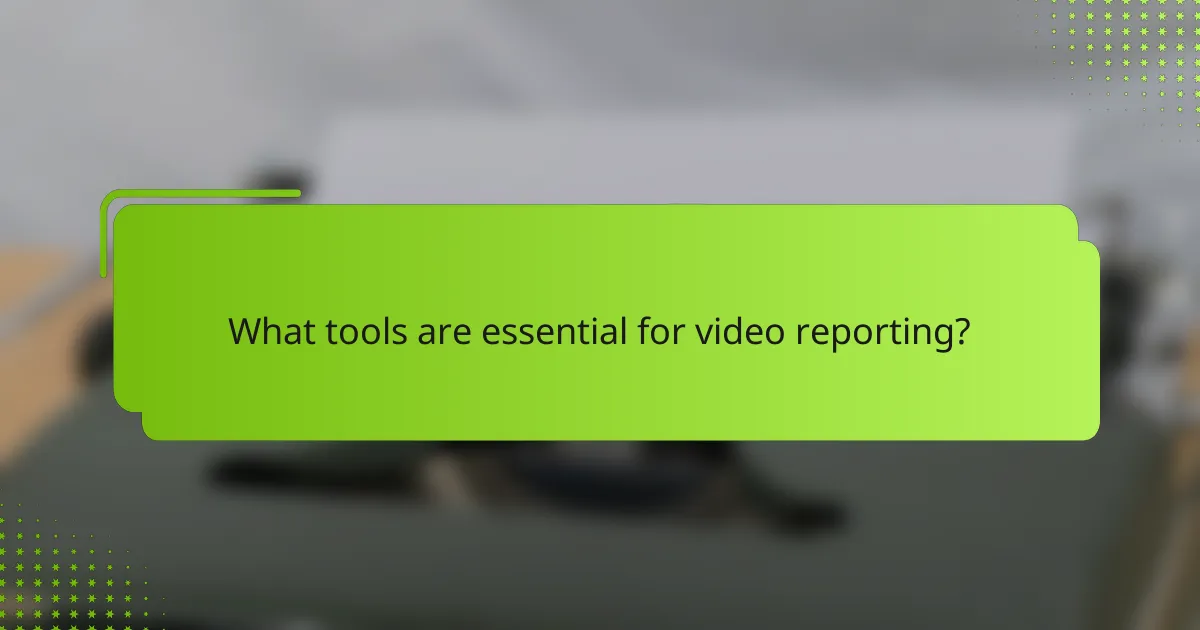Video reporting in developing countries serves as a powerful medium for highlighting local issues and fostering community engagement. By leveraging accessible technology and focusing on authentic narratives, reporters can create impactful stories that resonate with their audiences. Essential tools such as affordable cameras and user-friendly editing software further empower these storytellers to document challenges and inspire action within their communities.

What are effective video reporting strategies in developing countries?
Effective video reporting strategies in developing countries focus on community involvement, local narratives, and accessible technology. These strategies enhance storytelling and ensure that the content resonates with the audience while addressing local issues.
Community engagement techniques
Engaging the community is essential for successful video reporting. Techniques such as hosting workshops or community forums can help gather insights and foster participation. This involvement not only enriches the content but also builds trust and credibility among viewers.
Consider using social media platforms popular in the region to solicit feedback and ideas. This approach can facilitate real-time interaction and ensure that the reporting reflects the community’s voice and concerns.
Utilizing local storytellers
Local storytellers bring authenticity and cultural relevance to video reports. Collaborating with individuals who understand the community’s history and values can enhance the narrative. Their unique perspectives can help convey complex issues in relatable ways.
Look for local influencers or community leaders who can share their stories and experiences. This not only enriches the content but also encourages local audiences to engage with the material more deeply.
Leveraging mobile technology
Mobile technology is a powerful tool for video reporting in developing countries, where access to traditional media may be limited. Smartphones can be used for filming, editing, and sharing content quickly and efficiently. This accessibility allows reporters to capture real-time events and stories as they unfold.
Utilize apps that support video editing and social media sharing to streamline the process. Ensure that the content is optimized for mobile viewing, as many users may access videos on their phones.
Collaborating with NGOs
Partnering with non-governmental organizations (NGOs) can enhance the reach and impact of video reporting. NGOs often have established networks and resources that can support the production and distribution of content. They can also provide valuable insights into local issues and challenges.
When collaborating with NGOs, clearly define roles and expectations to ensure that the partnership is mutually beneficial. This can lead to more comprehensive storytelling that addresses the needs of the community while promoting the NGO’s mission.

How can video reporting address local issues?
Video reporting can effectively highlight and address local issues by providing a visual narrative that resonates with communities. It allows for the documentation of challenges faced by residents, fostering awareness and encouraging action from stakeholders.
Highlighting health challenges
Video reporting can bring attention to pressing health issues in developing countries, such as the prevalence of infectious diseases or inadequate healthcare facilities. By showcasing real stories from affected individuals, these reports can drive home the urgency of health crises.
For instance, a video could document the impact of malaria in a rural village, illustrating the struggles of families and the need for better access to medical resources. This approach not only informs viewers but also encourages local governments and NGOs to take action.
Documenting environmental changes
Video reporting serves as a powerful tool for documenting environmental changes, such as deforestation, pollution, and climate change effects. By capturing these changes visually, reporters can create compelling narratives that highlight the urgent need for environmental protection.
An example could be a series of videos showing the effects of rising sea levels on coastal communities, emphasizing the loss of land and livelihood. Such reports can galvanize public support for sustainable practices and policies.
Showcasing education initiatives
Video reporting can effectively showcase innovative education initiatives aimed at improving literacy and learning outcomes in developing countries. By highlighting successful programs, these reports can inspire replication and support from donors and policymakers.
For example, a video might feature a community-led initiative that uses mobile technology to enhance learning in remote areas. This not only raises awareness but also demonstrates practical solutions to educational challenges.

What tools are essential for video reporting?
Essential tools for video reporting include affordable camera equipment, user-friendly editing software, and reliable online distribution platforms. These tools enable reporters in developing countries to create and share impactful stories effectively.
Affordable camera equipment
When selecting camera equipment for video reporting, prioritize affordability and portability. Many smartphones today offer high-quality video capabilities, making them a practical choice for on-the-go reporting.
For those seeking dedicated cameras, options like DSLR or mirrorless cameras can be found in the mid-range price bracket, typically between $500 and $1,500. Look for models that support interchangeable lenses and have good low-light performance.
Editing software options
Editing software is crucial for refining video content. Free or low-cost options like DaVinci Resolve and HitFilm Express provide robust features suitable for beginners and experienced editors alike.
For those willing to invest, Adobe Premiere Pro and Final Cut Pro offer advanced capabilities but come with subscription or one-time purchase costs. Consider your budget and the software’s learning curve when making a choice.
Online distribution platforms
Distributing video content effectively is key to reaching audiences. Platforms like YouTube and Vimeo are popular choices, offering free hosting with monetization options for creators.
Social media channels such as Facebook and Instagram also serve as powerful distribution tools, allowing for quick sharing and audience engagement. Ensure your videos are optimized for each platform’s specifications to maximize reach.

What are the challenges of video reporting in developing countries?
Video reporting in developing countries faces several significant challenges, including limited internet access, funding constraints, and cultural sensitivities. These factors can hinder the effectiveness and reach of video journalism in these regions.
Limited internet access
Limited internet access is a major barrier to video reporting in developing countries. Many areas experience slow connections or no connectivity at all, making it difficult to upload or stream video content. Journalists must often rely on offline methods or seek locations with better access to share their work.
To navigate this challenge, reporters can consider using lower resolution video formats that require less bandwidth. Additionally, utilizing mobile networks or satellite connections can provide alternative solutions in areas with poor infrastructure.
Funding constraints
Funding constraints significantly impact video reporting capabilities in developing countries. Many journalists operate with minimal resources, which limits their ability to invest in quality equipment or training. This can result in lower production values and reduced storytelling effectiveness.
To address funding issues, reporters can explore partnerships with local NGOs, international organizations, or media grants. Crowdfunding platforms can also be a viable option to raise necessary funds for specific projects or initiatives.
Cultural sensitivities
Cultural sensitivities play a crucial role in video reporting within developing countries. Journalists must be aware of local customs, beliefs, and taboos to avoid offending communities or misrepresenting their stories. This requires thorough research and a respectful approach to storytelling.
Engaging with local communities and seeking their input can help ensure that reporting is culturally appropriate. Building trust with subjects can lead to more authentic narratives and encourage participation in the reporting process.

How can partnerships enhance video reporting?
Partnerships can significantly enhance video reporting by leveraging local knowledge, resources, and networks. Collaborating with various stakeholders can improve content relevance and accessibility, ensuring that the reporting resonates with the target audience.
Collaboration with local media
Working with local media outlets allows video reporters to tap into established audiences and gain insights into community issues. Local journalists often have a deeper understanding of cultural nuances and can provide valuable context that enriches the reporting.
To foster effective collaboration, consider sharing resources such as equipment, training, or even funding. This can lead to a mutually beneficial relationship where both parties enhance their storytelling capabilities and reach wider audiences.
Be mindful of potential challenges, such as differing editorial standards or competition for viewership. Establish clear communication and shared goals to ensure that the partnership is productive and aligned with both parties’ missions.



